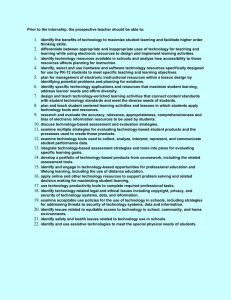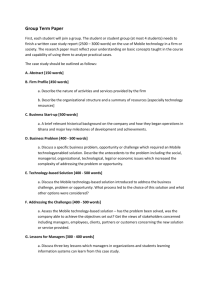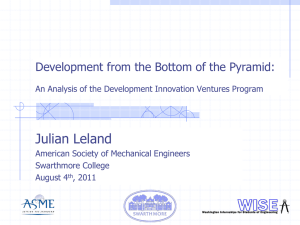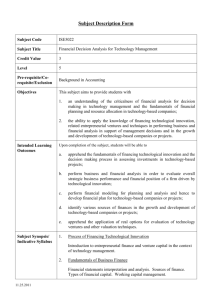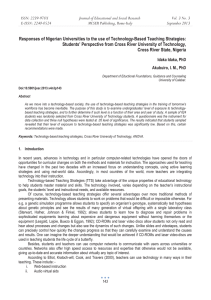advances in technology-based training
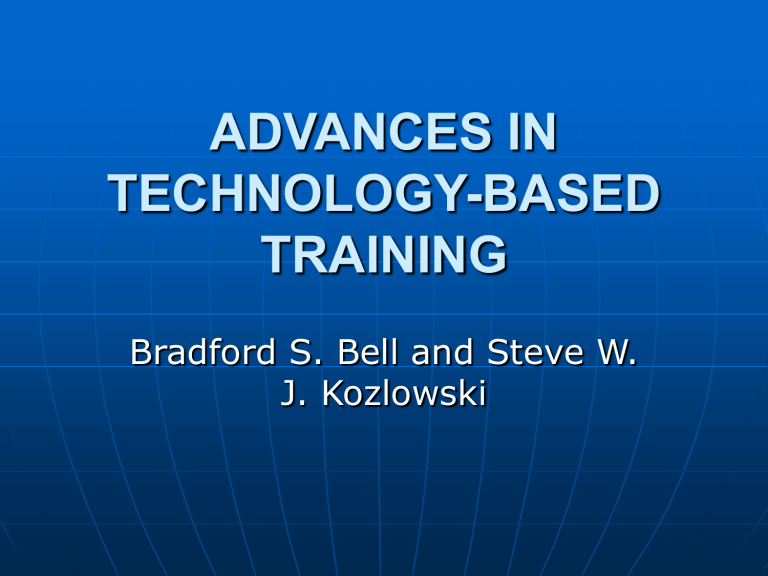
ADVANCES IN
TECHNOLOGY-BASED
TRAINING
Bradford S. Bell and Steve W.
J. Kozlowski
Chapter Topics
Environmental factors pushing companies to adopt technologybased training
Different technology-based training applications available in the marketplace
Chapter Topics Continued
Costs and benefits of technologybased training
Factors that influence technologybased training
Guidelines on the effective use of technology to deliver training and meeting human capital development needs
Environmental Factors Influencing
Technology-Based Training
Globalization
Economic pressures
Work/Life Issues
Globalization
Training costs can be prohibitive for highly decentralized organizations
Centralized classroom training is not an efficient means of delivering timely training to a global workforce
Technology is more responsive to training needs in this environment
Economic Pressures
Organizations must rely on workplace learning and continuous improvement to remain successful
Companies face tremendous economic pressures to cut costs and increase shareholder value
Economic Pressures Continued
Significant upfront costs
Helps organizations reduce variable costs associated with the classroom
Cost savings in other areas, such as program updating and employees’ time off the job
Work/Life Issues
Employees increasingly desire flexible work arrangements, such as telecommuting
Technology-based training can address the logistical problems of the flexible and telecommuting workforce
Technological Advances
Recent advances in computing power and connectivity
Greater bandwidth increases the multimedia capabilities of technology-based training
Technological Advances Cont.
Today’s high-end technologies can increasingly approximate conventional, instructor-led classroom training
Media that support these advanced technologies have become more cost-efficient, reliable, and accessible
Training Technologies
CD-ROM, DVD, and Interactive Video systems
Web-based training
Electronic performance support systems
(EPSS) and intelligent tutoring systems
Distributed interactive simulation (DIS), game-based training environments, and distributed mission training (DMT)
Benefits of Training Technology
Cost Reduction
Reduction in Training Time
Pedagogical Capabilities
Diversity and Accessibility
Other Benefits
Cost Reduction
Technology-based training can deliver a training program for lower cost than more traditional training methods
Reduces or eliminates many of the variable costs associated with the classroom
The up-front costs associated with technology-based training are significant
Reduction in Training Time
Technology-based training often leads to a reduction in the time that individuals spend in training
Less time off the job and greater employee productivity
Employees can learn precisely what they need to know
Pedagogical Capabilities
Highly personalized learning experience
Competency assessments can provide trainees with personalized feedback that is immediate
Training technology can give employees an opportunity to practice using their skills and knowledge in realistic situations
Diversity and Accessibility
Online learning can level social barriers
Increased access to individuals who otherwise may be unable to attend training or classes
Other Benefits
Makes it possible to deliver a consistent message companywide to all trainees or employees
Technology-based training can help create an environment in which learners have more responsibility for their personal success
Costs and Challenges of Training
Technology
Learner Choices
Social Environment and Collaboration
Learner Choices
Trainees exit training prior to achieving mastery of the subject
Trainees continue too long and become inefficient
Unwillingness to participate in online courses
Social Environment and
Collaboration
Minimal interactivity and communication capabilities
Does not provide employees with opportunities to socialize and network with their colleagues
Factors Affecting Effectiveness
Training content
Trainee characteristics
Training Content
Content may repeat classroom information (not effective)
Content may be heavily cognitive ignoring other types of training
Content may be a mix of classroom and technology (more flexible)
Trainee Characteristics
Cognitive ability
Goal orientation of the trainee
Prior achievement and knowledge
Conscientiousness
Openness to new experiences
Guidelines
Leverage the Unique Instructional
Capabilities of Technology
Adopt a Learner-Centered
Perspective
Create a Supportive Learning
Environment
Conclusion
Technology-based training offers the potential to revolutionize training effectiveness
Companies that realize this potential will be better positioned to leverage their human capital for sustained competitive advantage
